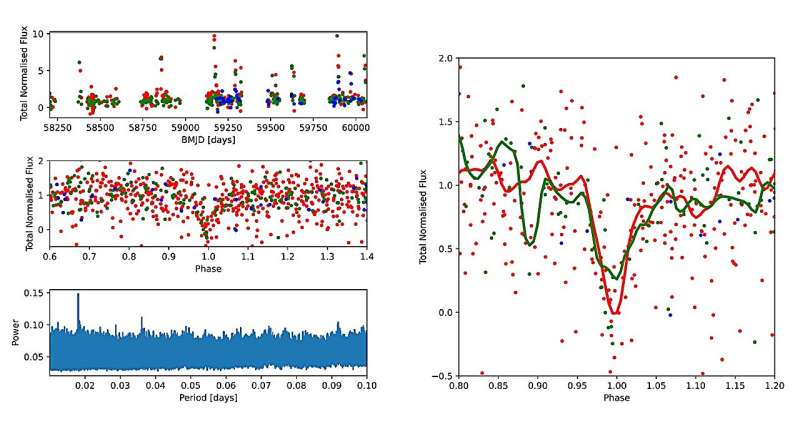December 29, 2023 report
This article has been reviewed according to Science X's editorial process and policies. Editors have highlighted the following attributes while ensuring the content's credibility:
fact-checked
preprint
trusted source
proofread
Zwicky Transient Facility detects four ultracompact binaries

By investigating dwarf novae identified by the Zwicky Transient Facility (ZTF), astronomers have discovered four binary systems. The objects turned out to be eclipsing accreting ultracompact white dwarf binaries. The finding was reported in a paper published December 15 on the pre-print server arXiv.
Observations show that accreting ultracompact binaries are white dwarfs in the process of stable accretion of material from a degenerate or semi-degenerate donor. Studying the evolution of such systems could help us advance our knowledge of the final fate of merging white dwarf binary stars.
Now, a team of astronomers led by Jasmine M. Khalil of the University of Amsterdam, The Netherlands, reports the detection of new systems of this type. Khalil's team combed through the list of more than 4,000 dwarf novae obtained with ZTF. As a result, they identified four eclipsing accreting ultracompact binaries, out of which one turned out to be reported by previous studies.
"We found four new eclipsing accreting ultracompact binaries with orbital periods between 25.9–56 minutes, one of which is previously published as an AM CVn [AM Canum Venaticorum-type star], while the other three systems are new discoveries," the researchers wrote in the paper.
The binaries identified by the astronomers are designated ZTF20aabowdt, ZTF18acgmwpt, ZTF19abugzba and ZTF21abbxnbm. ZTF18acgmwpt, located some 5,300 light years away, was first reported in 2021 and confirmed as an AM CV system with helium absorption lines in its spectrum.
As noted in the paper, the four binaries have orbital periods between 25.92 and 56.16 minutes. In general, accreting ultracompact binaries have orbital periods below 65 minutes, what means that their orbital evolution is governed by gravitational wave radiation.
The observations found that ZTF20aabowdt, ZTF18acgmwpt, and ZTF21abbxnbm exhibit deep eclipses. However, when it comes to ZTF19abugzba, it has a shallow eclipse with a depth of only about 50%. It was noted that ZTF20aabowdt also seems to showcase a narrower eclipse than other systems.
The astronomers noted that ZTF21abbxnbm, which has the longest orbital period out of the four binaries reported in the study, is unusual because it exhibits three super-outbursts in three years. This suggests that it is a helium cataclysmic variable (CV) instead of a typical long-period AM CVn like the other three systems.
The researchers added that although accreting ultracompact binaries systems are typically blue because the donor is cold and is not visible in the near-infrared, ZTF19abugzba and ZTF21abbxnbm showcase redder colors.
The authors of the paper propose high-speed photometry and spectroscopic follow-up observations to better characterize the reported systems as many of their properties still remain unknown.
More information: J. M. Khalil et al, Four new eclipsing accreting ultracompact white dwarf binaries found with the Zwicky Transient Facility, arXiv (2023). DOI: 10.48550/arxiv.2312.09980
Journal information: arXiv
© 2023 Science X Network




















